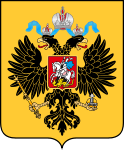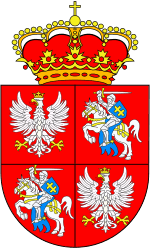Treaty of the Three Black Eagles
The Treaty of the Three Black Eagles (because all three signatories used a black eagle as a state symbol,[1] in contrast to the white eagle, a symbol of Poland) or the Treaty of Berlin (where it was signed by Prussia), was a secret treaty between the Austrian Empire, the Russian Empire and Prussia. Signed between Russia and Austria on 13 September 1732 and joined by Prussia on 13 December that year, it concerned the joint policy of those three powers in regard to the succession of the Polish throne in light of the expected death of the Augustus II of Poland (of the Saxon House of Wettin) and the Polish custom of royal elections. The three powers agreed that they would oppose another candidate from the House of Wettin, as well as the candidacy of the pro-French Pole Stanisław Leszczyński, father-in-law of Louis XV.[2] Instead, they chose to support either Infante Manuel, Count of Ourém, brother of the Portuguese king,[3] or a member of the Piast family.[4]
The Treaty of the Three Black Eagles had several goals. None of the three parties were serious about their support for the Portuguese count.[5] The agreement had provisions for all three powers agreeing that it was in their best interest that their common neighbour, the Polish-Lithuanian Commonwealth, did not undertake any reforms that might strengthen it,[6] and that its elected monarch should be friendly towards them.[2] In addition to the obvious - increasing the influence of the three powers over the Commonwealth - Austria and Russia also wanted to damage the possibility of a French-Prussian-Saxon alliance. Prussia received promises of support for its interests in Courland (now southern and western Latvia).[3]
Löwenwolde's Treaty
The political situation changed rapidly, and the Treaty of the Three Black Eagles was superseded soon after it was formulated. With the death of Augustus II on 1 February 1733, Austria and Russia distanced themselves from the earlier treaty, in that it was never ratified by the Empress of Russia.[3] Their primary goal, disruption of the French-Saxon-Prussian alliance, had already been achieved, so they sought to secure support from various Polish and Saxon factions. Thus on 19 August 1733, Russia and Austria entered into the Löwenwolde's Treaty with Saxony in the person of the new Elector, Frederick Augustus II of Saxony. The treaty was named after one of the chief diplomats involved in the negotiations, Russian Karl Gustav von Löwenwolde.
The terms of Löwenwolde's Treaty were straightforward. Russia would provide troops to ensure Frederick Augustus's election and coronation, while Frederick Augustus would, as the Polish king: (1) recognize Anna Ivanovna as Empress of Russia; (2) relinquish Polish claims to Livonia; and (3) remain unopposed to Russian interests[7] in Courland.[8] Austria received a promise that as king, Frederick Augustus would renounce any claim to the Austrian succession and respect the Pragmatic Sanction of 1713.[2]
Aftermath
Prussia allowed the French candidate, Leszczyński, safe passage across their lands,[9] and continued to oppose the election of Frederick Augustus.[10] Both Austria and Russia publicly declared in advance that they would not recognize Leszczyński if he were to be elected.[2] However the election sejm in Wola went ahead and picked Leszczyński on 12 September 1733, and the election was announced by the interrex Primate Potocki.[2][11] Diplomatic promises[2] and the arrival of Russian troops outside Warsaw on 20 September[8] caused a "rump" group, led by Michael Wisniowiecki (Great Chancellor of Lithuania) and Teodor Lubomirski (governor of Kraków) together with the Bishop of Poznań (Stanisław Józef Hozjusz) and the Bishop of Kraków (Jan Aleksander Lipski) to decamp to another Warsaw suburb where they held a new election, under the protection of the Russian troops, picking Frederick Augustus II of Saxony, who became Augustus III of Poland.[2]
The interference of various foreign powers into the Polish election led to the War of the Polish Succession (1733–1738), between Augustus III with his foreign allies Austria and Russia against the supporters of Stanisław Leszczyński and France. Prussia reluctantly sent 10,000 troops.[3] In the Treaty of Vienna of 1738 which formally ended the war, Stanisław Leszczyński renounced his claim to the Polish throne[12] Leszczyński was made Duke of Lorraine in compensation.[9]
Name
The Three Black Eagles are referencing the respective coats of arms of the involved countries, as contrasted to the Polish White Eagle.
-

The State Emblem of the Russian Empire
-
.png)
The Coat of arms of the Austrian Empire
-

The Black Eagle of Prussia
-

Coat of arms of Polish-Lithuanian Commonwealth, the White Eagle was the coat of arm of Crown of the Kingdom of Poland, Pogoń Litewska was coat of arm of Grand Duchy of Lithuania
See also
Notes
- ↑ Cierlińska, Hanna (1982) A Panorama of Polish History Interpress Publishers, Warsaw, Poland, page 73, ISBN 83-223-1997-5
- 1 2 3 4 5 6 7 Corwin, Edward Henry Lewinski (1917) The political History of Poland Polish Book Importing Company, New York, page 286–288, OCLC 626738
- 1 2 3 4 Tuttle, Herbert and Adams, Herbert Baxter (1883) History of Prussia. Houghton, Mifflin and Company, pages 369–371
- ↑ Gieysztor, Aleksander, et al. (1979) History of Poland PWN, Polish Scientific Publishers, Warsaw, Poland, page 244, ISBN 83-01-00392-8
- ↑ Schlosser, Friedrich Christoph (1844) History of the eighteenth century and of the nineteenth till the overthrow of the French empire: Volume III Chapman and Hall, London, page 294, OCLC 248862784
- ↑ Marácz, László Károly (1999) Expanding European unity: Central and Eastern Europe Rodopi, Amsterdam, The Netherlands, page 134, ISBN 90-420-0455-X
- ↑ In effect support the rule of Ernest Biron, a Russian court favorite. Corwin, Edward Henry Lewinski (1917) The political History of Poland Polish Book Importing Company, New York, page 288, OCLC 626738
- 1 2 Ragsdale, Hugh (1993) Imperial Russian foreign policy Cambridge University Press, Cambridge, England, page 32–33, ISBN 0-521-44229-X
- 1 2 Lindsay, J. O. (1957) The New Cambridge Modern History Cambridge University Press, Cambridge, England, page 205, ISBN 0-521-04545-2
- ↑ Kelly, Walter Keating (1854) The History of Russia: From the Earliest Period to the Present Time Harvard University, Cambridge, Massachusetts, pages 408–409
- ↑ William Macpherson indicated that Leszczyński's election was partially due to French gold. Macpherson, William (editor) (1845) "Chapter CXXXIII Annals of France, from the Accession of Louis XV, to the Period following the Peace of Aix-la-Chapelle" Encyclopaedia Metropolitana Volume XIII: History and Biography Volume 5 B. Fellowes, London, page 144, OCLC 4482450
- ↑ Stanisłas Leszczyński renounced the throne 'voluntarily and for the sake of peace', which implied that his election had been legal. Lindsay, J. O. (1957) The New Cambridge Modern History Cambridge University Press, Cambridge, England, page 205, ISBN 0-521-04545-2